
Process mapping is a well-known technique for creating a common vision and shared language for improving business results. It helped one management training and development firm realize that people within their sales department had been working at cross purposes, and crucial executive-level discussions with customers were not taking place. Based on sales process mapping, the leaders reorganized their sales operations so that job descriptions and performance measures focused more on the customer. In six months, they reversed a five-year slump and earned big bonuses for team members. In another case, sales process mapping helped a large manufacturer’s national account teams discover a powerful new way to coordinate with field salespeople, yielding far more new business opportunities than expected.
However, leaders in both large and small sales organizations often make mistakes that undermine the potential of process mapping. A common result, for example, is that salespeople ignore the process and operate “outside the system.” Based on work with several dozen clients, I’ve observed four common mistakes that tend to hinder their success:
|
|||||||||||||||||||||||||
This article describes the consequences of these sales process mapping errors, as well as principles to follow in order to avoid them. By following these suggestions, you can derive the most positive results for your own organization.
Mistake #1: Map all the trees, but miss the forest
An enthusiastic VP of Sales for a technical services company spent considerable time developing a process map for his organization. The map he developed (Figure 1) is typical of a first attempt to map a sales process. Analytically trained individuals (such as Six Sigma Black Belts or IT Systems Analysts) often create similar maps, many pages festooned with decision diamonds and other complicated details.
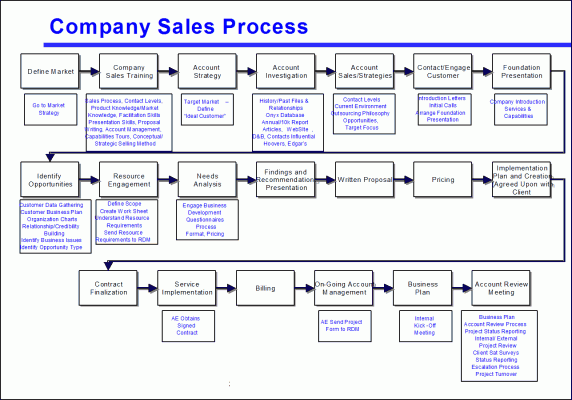
This VP created a comprehensive snapshot of people’s activities across his sales organization. Unfortunately, his comprehensive process map did not help him train or lead his team. This process map illustrates Mistake #1 in two significant ways:
- The map is too detailed. It captures more information than a person can take in all at once.
- All activities appear to have the same importance, with each activity equally dependent on the previous one. This isn’t an accurate reflection of reality.
Principle #1: Foreground goals in your sales process map
The figure below shows how this VP’s sales process map could be organized around goals. This technique places goals in the foreground, clarifying key issues. For example, even if team members have different ideas about how to qualify new accounts, they can agree that accounts must be qualified. With this goal in the foreground, some variation can be expected in how the goal is achieved. As individuals work toward consensus in the activity steps, they become best practices for achieving the goals.
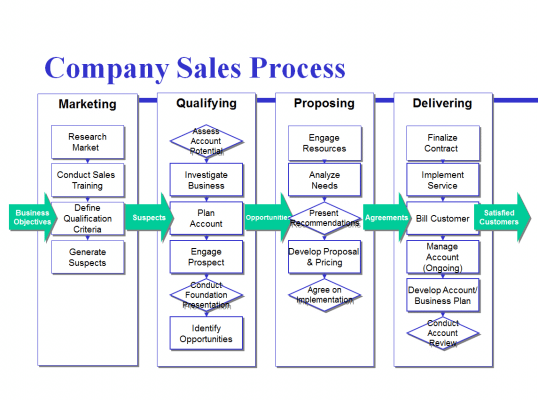
Note that the goals are not the same as departmental boundaries. A single person might be involved in any of the top-level phases. This drives communication and collaboration, making process maps a powerful tool for generating a shared framework for accountability.
Another important feature is decision diamonds showing where the prospect (or the salesperson) might opt out. In real life, prospects can decide to buy from someone else, wait until next year, or call out of the blue and need service tomorrow. Identifying and measuring these decision points acknowledges that the process has a yield, as well as providing critical information for process improvement.
Mistake #2: Focus on the seller, instead of the customer
An administrator in a financial services company mapped her company’s sales process as her thesis for a master’s degree program. She dutifully collected statements from the company’s sales executives about what salespeople ought to do (she had never been a salesperson herself) and organized them into a hierarchical format. She achieved a thorough analysis that satisfied her professors. Unfortunately, her hard work did not benefit her organization.
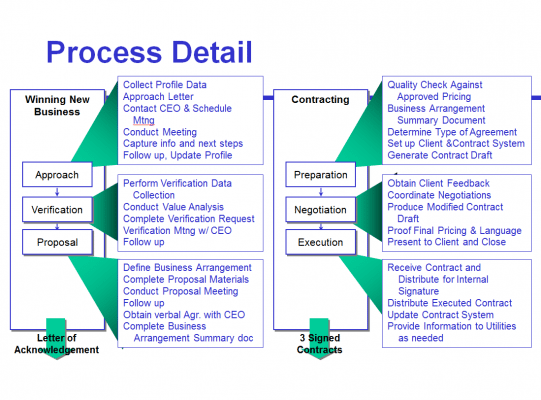
A portion of her company’s process map is shown in Figure 3. It is hierarchical, identifying a goal for each phase. Notice that the steps in the Winning New Business phase call for working with the CEO at each step. It would be nice if that happened, wouldn’t it? Now, consider the steps within the Contracting phase. Who do these steps create value for? From an internal administrator’s perspective, these procedures are important. But what value do they create for the customer? In fact, the benefit to the external customer was not considered at any stage of this process. Is it any wonder customers resisted it? Successful salespeople in this administrator’s company routinely operated outside the process, as any successful salesperson would have to do.
Principle #2: Determine how to create value for the customer
Sales processes that work create value for the customer. Delegating the process mapping task to an administrator without sales experience or executive insight allowed this company to go through the motions without making a difference. Figure 4 shows what this company’s process might look like, recast with a customer focus. Figure 5 defines value to the customer.
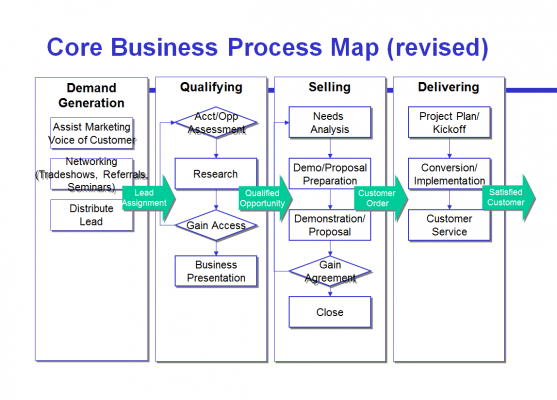
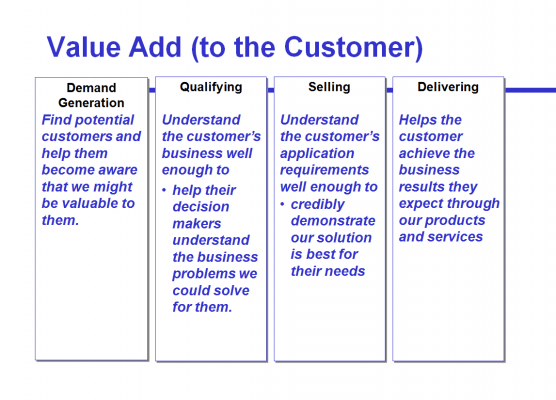
These diagrams illustrate a lengthier, more complex sales processes often found in business-to-business services. Such an approach is important where substantial talent or time – such as engineering, IT, legal, or other consulting – is necessary to develop a solution proposal. These complex sales environments are notorious for their unpredictability and cost. Before committing costly resources to the sales effort, the selling organization must do everything possible to ensure success and avoid wasting those resources. This can be accomplished by reaching decision makers early, so as to verify their needs and priorities. But this usually requires tremendous effort and courage. Often it is never accomplished.
Ultimately, reaching the decision maker in your customer’s organization benefits both you and your customer. Without first-hand insight into the decision maker’s needs and priorities, you risk wasting everyone’s time. But if you can validate your own understanding of the business value you offer the decision maker, even helping the decision maker generate a consensus if necessary, you create value for everyone. Getting credit for these things is often the key to winning the business.
Through sales process mapping, your team can keep a constant focus on your most mission-critical question: How can you create real value to the customer? If your business requires a contracting/administrative phase (like the financial services company in Figure 3), figure out how that phase can create value for the customer. If you can’t, place that phase in service of another goal that does.
Everything you do to find, gain, and keep customers should create clear value for them. If you do, customers – and the best salespeople – are sure to follow. You have no more powerful lever for ensuring an ever-growing stream of profitable business. Customer value is the number one defense against changing markets, competition, and technologies.
Mistake #3: Forget to “show them the money”
The training and development department of a major corporation spent several million dollars to develop a customized sales training program based on the company’s cultural values. The program was magnificent from an organizational development perspective. It illustrated the company’s conceptual goals clearly, and it built on existing training materials, which provided salespeople with many powerful skills (see Figure 6).
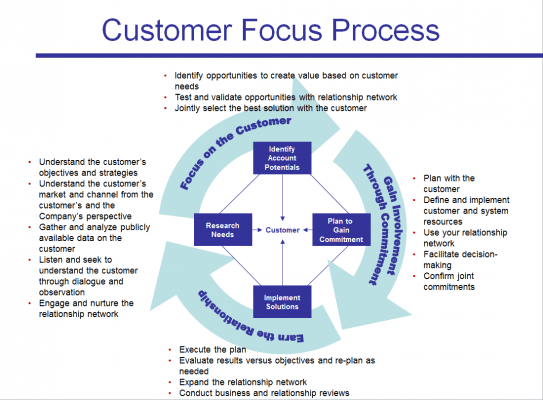
Unfortunately, statements such as “Use the relationship network,” “Facilitate decision making,” or “Confirm joint commitments” are not useful to salespersons trying to make their numbers. What is the concrete output of each step? How will it be measured? When are orders generated? Where is the process connected to the money?
Lacking measurable steps grounded in real-world sales operations, the training program defined a process in name only. Salespeople learned how the company’s world really worked on the job rather than from the course. Although many people agreed the course contained valuable skills, its value could not be proven. The sales organization in this company ultimately created its own measurement system outside the framework of the training program, crippling its effectiveness.
Principle #3: Integrate tools, skills, and results measurements with the process
Figure 7 illustrates how a sales process map (the same map that appears in Figure 2) can include metrics. The sales organization’s performance is measured by the high-level goals of the process, rather than the detail steps. There are many advantages in this approach to selecting metrics.
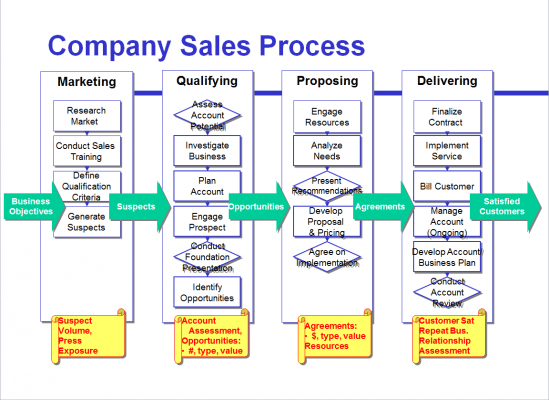
First, as products and services move through their economic life cycles, sellers must change their marketing and qualifying strategies accordingly. Over time, these metrics can provide powerful leading indicators of market shifts, affording sellers precious lead time to respond.
Second, these metrics allow the organization to identify its bottlenecks or weak links, allowing resources to be allocated most effectively. For example, if marketing is not generating enough good prospects, adding salespeople or engaging expensive training services will not help. Instead, the marketing process should be improved so as to create enough prospects.
Third, a mapping approach allows people to participate in setting their own goals by drilling into more detailed analyses and metrics to improve performance. Figure 8 illustrates how a process map can serve as a tool for integrating some support functions within an organization.
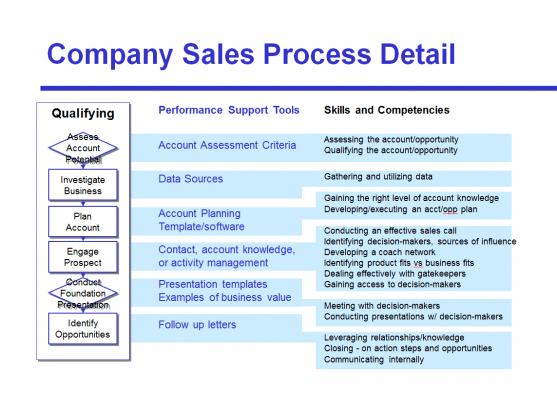
Individuals can use this kind of detail to identify skills they need to work on. An organization can use process detail to integrate software support as well as training. This kind of mapping, a current trend in the training and development community, can yield powerful results.
Mistake #4: Buy somebody else’s “ideal” sales process
Sales processes often come prepackaged as sales training or Customer Relationship Management (CRM) software. Although these initiatives can be useful to an organization if they are selected and implemented appropriately, they sometimes do great harm.
For example, sales executives purchase sales training in an attempt to create improved sales results. Good sales training does in fact help salespeople become more effective at reaching their goals. But, like everyone else, salespeople are creatures of their environment. If the environment is not changed, behaviors tend to return to their pre-training state. Although this problem is well known, sales executives often do not recognize the impact of mismatches between their own organization’s sales environment and the assumptions of a sales training program. Many millions of dollars are wasted each year in training programs that are far less effective than they could be for this reason.
In the case of CRM software, a company is often faced with fitting its business to the software, instead of the other way around. Anxious to collect license fees, software firms generally recommend, “Let’s just get the software running vanilla for now; then down the road we can think about modifying it.” Down the road, most companies discover many dubious assumptions:
|
|||||||||||||||||||||||||
Many organizations have found CRM implementations to be extremely frustrating experiences. Why do so many organizations find themselves in this situation? One reason is that executives assume that everyone else already understands how their business works, so someone else (such as the software vendor or an administrator) can map out the details.
However, if people within the organization haven’t created a reasonable map of the sales process for themselves, how can they expect an outside supplier’s assumptions to be on the mark? In this regard, Dick Lee, author of The Customer Relationship Management Survival Guide, offers a valuable perspective:
“Customer Relationship Management means implementing customer-centric business strategies, which drives redesigning of functional activities, which demands re-engineering of work processes, which is supported, not driven, by CRM technologies.”
CRM software is very powerful. It requires answers to questions such as, “How do we create value for customers?” and “How do we measure the value we create?” If leaders in the organization don’t fully account for the answers, the initiative will fail – not because the CRM product is inadequate but because the organization didn’t create an environment in which it could work.
Principle #4: Engage your people in process mapping to define problems and solutions
Software and training suppliers can provide valuable tools to support your sales process. But the sales process itself can’t be purchased from an outside supplier. It requires the hearts and minds of your people. It is the hearts and minds of your people. It is your customer relationship strategy. The leaders of a sales organization need to generate a common vision and implement it collaboratively. Process mapping is an ideal tool to engage people in creating and achieving this common vision.
Conclusion
The best salespeople in an organization often operate outside the parameters of whatever sales process or CRM system is in place. They get away with it because they provide the organization’s supply of oxygen-customers with orders. Thank goodness!
It is time to challenge one of the traditional approaches of leaders who function as cheerleaders for their sales teams, while turning a blind eye toward internal roadblocks and constraints. Process mapping, accomplished through team collaboration, with clear focus on customer value at every stage, is a power tool for blowing away those roadblocks and constraints.
In summary, sales process mapping provides these mission-critical benefits to any customer-facing organization:
- It enables the team to tap into the customer’s oxygen pipeline and trace a path to your business.
- It ensures that the team can pull together to create real value, so salespeople don’t have to go outside the system to deliver desperately needed oxygen.
- It helps individuals understand and accept organizational changes across functions.
- It provides the framework for measuring performance goals, which people can set for themselves.
These are the reasons why process mapping brings such potential for creating breakthroughs in organizational sales performance.